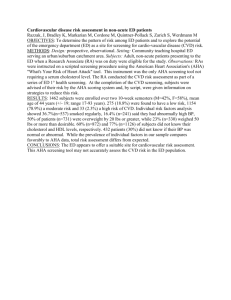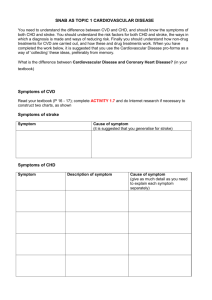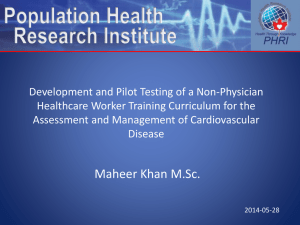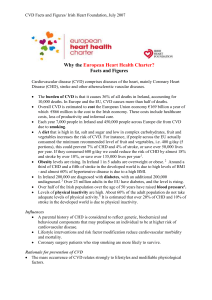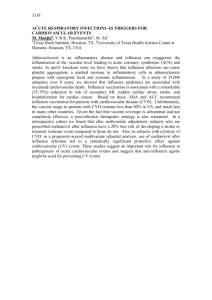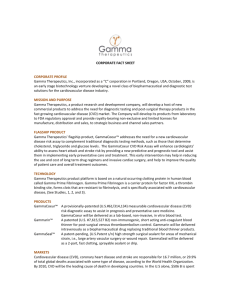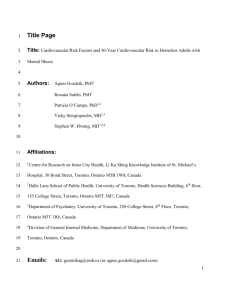Women`s No. 1 Health Threat - American Heart Association
advertisement
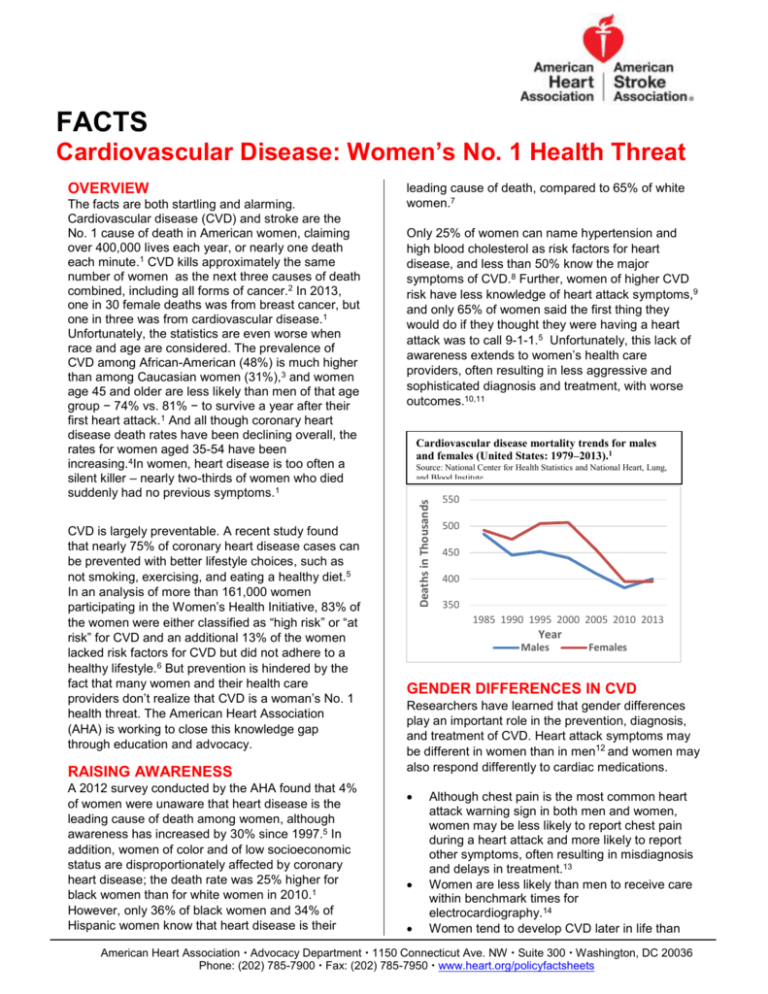
FACTS Cardiovascular Disease: Women’s No. 1 Health Threat The facts are both startling and alarming. Cardiovascular disease (CVD) and stroke are the No. 1 cause of death in American women, claiming over 400,000 lives each year, or nearly one death each minute.1 CVD kills approximately the same number of women as the next three causes of death combined, including all forms of cancer.2 In 2013, one in 30 female deaths was from breast cancer, but one in three was from cardiovascular disease.1 Unfortunately, the statistics are even worse when race and age are considered. The prevalence of CVD among African-American (48%) is much higher than among Caucasian women (31%),3 and women age 45 and older are less likely than men of that age group − 74% vs. 81% − to survive a year after their first heart attack.1 And all though coronary heart disease death rates have been declining overall, the rates for women aged 35-54 have been increasing.4In women, heart disease is too often a silent killer – nearly two-thirds of women who died suddenly had no previous symptoms.1 CVD is largely preventable. A recent study found that nearly 75% of coronary heart disease cases can be prevented with better lifestyle choices, such as not smoking, exercising, and eating a healthy diet.5 In an analysis of more than 161,000 women participating in the Women’s Health Initiative, 83% of the women were either classified as “high risk” or “at risk” for CVD and an additional 13% of the women lacked risk factors for CVD but did not adhere to a healthy lifestyle.6 But prevention is hindered by the fact that many women and their health care providers don’t realize that CVD is a woman’s No. 1 health threat. The American Heart Association (AHA) is working to close this knowledge gap through education and advocacy. RAISING AWARENESS A 2012 survey conducted by the AHA found that 4% of women were unaware that heart disease is the leading cause of death among women, although awareness has increased by 30% since 1997.5 In addition, women of color and of low socioeconomic status are disproportionately affected by coronary heart disease; the death rate was 25% higher for black women than for white women in 2010.1 However, only 36% of black women and 34% of Hispanic women know that heart disease is their leading cause of death, compared to 65% of white women.7 Only 25% of women can name hypertension and high blood cholesterol as risk factors for heart disease, and less than 50% know the major symptoms of CVD.8 Further, women of higher CVD risk have less knowledge of heart attack symptoms,9 and only 65% of women said the first thing they would do if they thought they were having a heart attack was to call 9-1-1.5 Unfortunately, this lack of awareness extends to women’s health care providers, often resulting in less aggressive and sophisticated diagnosis and treatment, with worse outcomes.10,11 Cardiovascular disease mortality trends for males and females (United States: 1979–2013).1 Source: National Center for Health Statistics and National Heart, Lung, and Blood Institute. Deaths in Thousands OVERVIEW 550 500 450 400 350 1985 1990 1995 2000 2005 2010 2013 Year Males Females GENDER DIFFERENCES IN CVD Researchers have learned that gender differences play an important role in the prevention, diagnosis, and treatment of CVD. Heart attack symptoms may be different in women than in men12 and women may also respond differently to cardiac medications. Although chest pain is the most common heart attack warning sign in both men and women, women may be less likely to report chest pain during a heart attack and more likely to report other symptoms, often resulting in misdiagnosis and delays in treatment.13 Women are less likely than men to receive care within benchmark times for electrocardiography.14 Women tend to develop CVD later in life than American Heart Association Advocacy Department 1150 Connecticut Ave. NW Suite 300 Washington, DC 20036 Phone: (202) 785-7900 Fax: (202) 785-7950 www.heart.org/policyfactsheets FACT SHEET: Cardiovascular Disease: Women’s No. 1 Health Threat men, and their outcomes are often worse.1 Women smokers die of a heart attack caused by smoking earlier than men. Women who smoke are more than twice as likely to die of sudden cardiac death, compared to women who have never smoked.15,16 Women with acute coronary syndrome are more likely than men to have adverse outcomes, including death, heart attack, stroke, or rehospitalization, even after adjusting for age differences.17 Previous studies and clinical trials have often not been done with adequate numbers of women in the study population, and thus, their conclusions are not always generalizable to women. Only 34% of clinical trial subjects in cardiovascular research are women, and just 31% of those studies report outcomes by sex, making it difficult for researchers and clinicians to draw conclusions about their effects on women.18 Likewise, in an analysis of more than 120 studies of 78 FDA-approved medical devices between 2000 and 2007, women made up only one-third of the participants in the studies that reported sex distribution; 28% of the studies didn’t provide the gender of the patients enrolled in the trials.19 Researchers have identified gender differences in response to cardiac medications. Drugs that are beneficial for men may even be harmful to women. For example, the drug digoxin used to treat patients with heart failure was associated with an increased risk of death among women, but not men.20 DIAGNOSIS AND TREATMENT DISPARITIES Women are less likely than men to receive aggressive diagnosis and treatment for CVD. Among Medicare patients, men are two to three times more likely than women to receive an 1 Mozaffarian, D., et al. Heart disease and stroke statistics-2015 update: a report from the american heart association. Circulation. 2015. 131(4): e29-e322. 2 Centers for Disease Control and Prevention. Deaths: Final data for 2013. National Vital Statistics Reports Vol. 64, Number 2. (forthcoming). 3 National Center for Health Statistics (NCHS) and National Heart, Lung, and Blood Institute. National Health and Nutrition Examination Survey 2009 to 2012. 4 Ford ES. Trends in predicted 10-year risk of coronary heart disease and cardiovascular disease among U.S. adults from 1999 to 2010. J Am Coll Cardiol 2013;61:2249–52. 5 Chomistek, AK., et al. Healthy lifestyle in the primordial prevention of cardiovascular disease among young women.Journal of the American College of Cardiology. 2015. 65. 1: 43-51. 6 Hsia, J, et al. Evaluation of the American Heart Association CVD Prevention Guideline for Women. Circ Cardiovasc Qual Outcomes. 2010;3:128-134. 7 Mosca L.,Hammond G, Mochari-Greenberger, H. Fifteen-Year trends in awareness of heart disease in women: results of a 2012 American Heart Association national survey: Circulation.2013;127:1254-1263. 8 McDonnell, LA, et al. Perceived vs actual knowledge and risk of heart disease in women: findings from a Canadian survey on heart health awareness, attitudes, and lifestyle. Canadian Journal of Cardiology.2014. 30.7: 827-834. 9 Flink, LE., et al. Women at Risk for Cardiovascular Disease Lack Knowledge of Heart Attack Symptoms. Clin Cardio.2013. 36(3): 133-138. 10 Menezes AR, et al. Cardiac rehabilitation in the United States. Prog Cardiovasc Dis 2013. 2014;56:522–9. 11 Meisel, ZF., et al.Multicenter validation of the Philadelphia EMS admission rule (PEAR) to predict hospital admission in adult patients using out-of-hospital data. Acad Emerg Med. 2009. 16(6): 519-525. 12 McSweeney JC, et al.Cluster analysis of women’s prodromal and acute myocardial infarction symptoms by race and other characteristics.J Cardiovasc Nurs. 2010;25(4):311Y322. 13 Canto JG, et. al. Symptom presentation of women with acute coronary syndromes: myth vs. reality. Arch Intern Med 2007; 167:2405-2413. implantable cardioverter-defibrillator for the prevention of sudden cardiac death.21 Only about 33% of all percutaneous coronary interventions were performed on women in 2010.1 One in 6 women (about 16 million women) between the ages of 18 and 64 are uninsured.22 Uninsured women are more likely to have inadequate access to care, get a lower standard of care when they are in the health system, and have poorer health outcomes. Women are more likely than men to have forgone needed health care due to cost.23 THE ASSOCIATION ADVOCATES The nation has made remarkable progress in reducing the overall rates of death and disability from CVD in men. Realizing a comparable level of improvement for women requires the concerted efforts of everyone. The AHA applauds enactment of a provision in the Food and Drug Administration Safety and Innovation Act that requires the FDA to develop an Action Plan to address the findings of a recent FDA report documenting continuing gaps in the participation of women in clinical trials, the analysis of sex differences, and the availability of sex-specific data to clinicians, researchers, and patients. AHA is now working with FDA to implement this provision. The AHA supports expanding to all 50 states the WISEWOMAN program, which provides free CVD screening and lifestyle counseling to lowincome uninsured or under-insured women. AHA supports improved reporting of health care data by sex, race, and ethnicity. AHA is working to implement provisions of the Affordable Care Act that will make health insurance more accessible and affordable for women as well as men. McSweeney, JC et al. Women’s early warning symptoms of acute myocardial infarction. Circulation. 2013 108.21: 2619-2623. 15 Hurley, MA. Light smoking at base-line predicts a higher mortality risk to women than to men; evidence from a cohort with long follow-up. BMC public health.2014. 14.1 (2014): 95. 16 Grundtvig M, et al. Sex-based differences in effect of smoking: first acute myocardial infarction occurs more prematurely in women than in men. European Society of Cardiology Congress Poster Session. September 2008. 17 Gupta, A, et al. Trends in acute myocardial infarction in young patients and differences by sex and race, 2001 to 2010. Journal of the American College of Cardiology.2014: 64.4: 337-345. 18 Melloni C., et al., Representation of women in randomized clinical trials of cardiovascular disease prevention.Circ Cardiovasc Qual Outcomes, 2010 Mar; 3(2): 135-42. 19 Dhruva, SS, Bero, L, and Redberg, R. Gender Bias in Studies for Food and Drug Administration Premarket Approval of Cardiovascular Devices. Circulation: Cardiovascular Quality and Outcomes. 2011; 4: 165-171. 20 Rathore SS, et alSex-based differences in the effect of digoxin for the treatment of heart failure. New England Journal of Medicine 2002; 347(18): 1403-1411. 21 Sahni, S et al. Gender Bias Trends in Implantable Cardioverter-Defibrillator Therapy. Current Cardiovascular Risk Reports.2014: 8.3: 1-6. 22 U.S. Census Bureau, Current Population Survey, Annual Social and Economic Supplement, 2014 23 Centers for Disease Control and Prevention, National Center for Health Statistics, National Health Interview Survey, 2007-2009. Analysis conducted by the Maternal and Child Health Information Resource Center. 14 AHA/HPFS/2/2015
